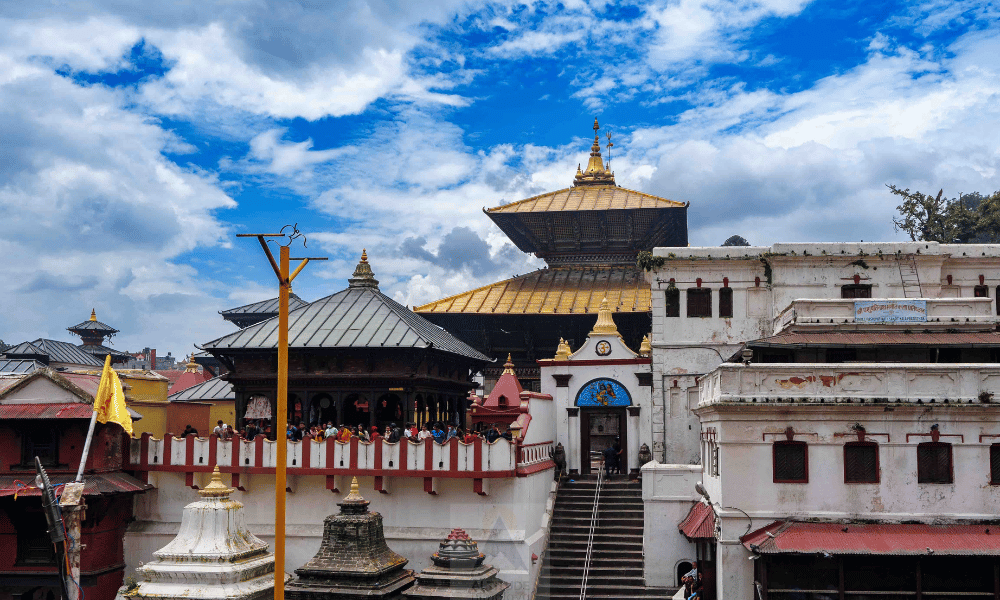Pashupatinath Temple, nestled on the banks of the Bagmati River in Kathmandu, Nepal, stands as a testament to the profound spiritual and cultural heritage of the region. Revered as one of the holiest temples dedicated to Lord Shiva, Pashupatinath is not just a religious landmark but also a vibrant cultural hub that encapsulates the essence of Nepal’s rich traditions. This sacred temple, a UNESCO World Heritage Site since 1979, is more than a place of worship; it is a confluence of faith, rituals, art, and history that continues to attract devotees and tourists from all over the world.
Pashupatinath Temple is one of the most significant temples for followers of Hinduism, especially Shaivites who worship Lord Shiva as their supreme deity. The temple’s name, “Pashupatinath,” is derived from two words: “Pashu,” meaning living beings, and “Pati,” meaning lord or protector. Thus, Pashupatinath signifies “the lord of all living beings,” embodying Lord Shiva’s role as the protector of life and the universe.
The temple is believed to have existed for centuries, with its origins shrouded in myths and legends. One of the most popular legends surrounding the temple’s creation tells the story of Lord Shiva assuming the form of a deer and wandering into the forests of Kathmandu. The gods, upon discovering him, tried to bring him back to his divine abode. In the struggle, one of Shiva’s horns broke, and the broken piece was later discovered by a herder, leading to the establishment of the Pashupatinath Temple.
The temple complex houses the sacred Linga of Pashupatinath, a phallic symbol representing Lord Shiva. This Linga is believed to have self-manifested, adding to the temple’s sanctity. Pilgrims from across the globe visit Pashupatinath to offer their prayers, seek blessings, and perform rituals, especially during the Maha Shivaratri festival, when the temple becomes a vibrant center of devotion.
Pashupatinath Temple is not just a spiritual center but also an architectural marvel that showcases the intricate craftsmanship of ancient Nepalese artisans. The temple is built in the traditional pagoda style, with tiered roofs adorned with gold-plated copper, and the wooden struts are intricately carved with images of deities. The two-level roofs and four silver-plated doors, each decorated with symbols and statues, reflect the temple’s grandeur and the deep religious symbolism embedded in its design.
The temple’s sanctum sanctorum, where the sacred Linga resides, is surrounded by several smaller shrines and ashrams, each with its religious significance. The complex is also home to the sacred Bagmati River, where devotees take ritual baths to purify themselves before entering the temple. The river is considered so holy that cremation along its banks is believed to liberate the soul, ensuring it attains Moksha or liberation from the cycle of birth and death.
The cultural significance of Pashupatinath extends beyond its architecture. The temple is a living museum of Nepalese culture, where ancient rituals, music, dance, and art continue to thrive. The traditional music played during religious ceremonies, the rhythmic chants of mantras, and the vibrant festivals celebrated within the temple complex all contribute to the preservation of Nepal’s intangible cultural heritage.
Pashupatinath Temple is the epicenter of numerous religious festivals and rituals, each reflecting the deep-rooted cultural traditions of Nepal. Among these, Maha Shivaratri is the most significant. Celebrated in honor of Lord Shiva, Maha Shivaratri attracts thousands of pilgrims, sadhus (holy men), and tourists from around the world. The temple complex becomes a hive of activity, with devotees fasting, praying, and performing rituals throughout the night, seeking the blessings of Pashupatinath.
Another important festival is Teej, celebrated primarily by women who fast and pray for the well-being of their husbands and families. The temple becomes a sea of red as women dressed in traditional red saris gather to offer prayers to Lord Shiva and Goddess Parvati. The vibrant atmosphere, filled with the sound of devotional songs and the sight of women performing traditional dances, showcases the deep connection between spirituality and cultural expression.
The temple also plays a crucial role during the final rites of the deceased. The ghats (cremation platforms) along the Bagmati River are a constant reminder of the transient nature of life. The sight of funeral pyres, the chanting of priests, and the flow of the sacred river create a poignant atmosphere that underscores the spiritual belief in the cycle of life, death, and rebirth.
Pashupatinath Temple is not only a religious pilgrimage site but also a major tourist attraction that draws visitors interested in exploring Nepal’s cultural and historical heritage. The temple’s inclusion in the list of UNESCO World Heritage Sites has further enhanced its appeal to international tourists, who come to experience its spiritual ambiance and architectural splendor.
Tourism at Pashupatinath is a unique blend of religious and cultural exploration. Visitors can witness the daily rituals performed by priests, participate in festivals, and observe the cremation ceremonies, gaining insight into the Hindu way of life. The temple also offers a glimpse into Nepal’s rich history, with ancient inscriptions, sculptures, and artifacts that tell the story of the region’s spiritual evolution.
In recent years, the Nepalese government and local authorities have taken steps to preserve and promote the temple’s cultural heritage while ensuring that the influx of tourists does not compromise its sanctity. Efforts have been made to provide better facilities for pilgrims and tourists, including guided tours, informative signboards, and the promotion of eco-friendly practices within the temple complex.
Pashupatinath Temple holds a special place in the hearts of the Nepalese people, serving as a symbol of national identity and cultural pride. The temple is not just a place of worship but also a center for social and charitable activities. It supports various initiatives aimed at preserving Nepal’s cultural heritage, including the training of traditional musicians, dancers, and artisans, as well as the promotion of Sanskrit education.
The temple also plays a vital role in the social fabric of Kathmandu. It provides a space for communal gatherings, where people come together to celebrate festivals, perform rituals, and seek solace in times of need. The temple’s presence in the capital city serves as a constant reminder of the spiritual values that underpin Nepalese society, fostering a sense of unity and continuity among its people.
Pashupatinath Temple is much more than a religious site; it is a living embodiment of Nepal’s spiritual and cultural heritage. The temple’s rich history, architectural beauty, and vibrant traditions make it a unique destination for both pilgrims and tourists. As Nepal continues to navigate the challenges of modernization, Pashupatinath remains a steadfast guardian of its ancient traditions, ensuring that the cultural and spiritual legacy of the region endures for future generations.
Read More: https://tourisminfonepal.com/pashupatinath-a-divine-pilgrimage-and-tourism-hub/






